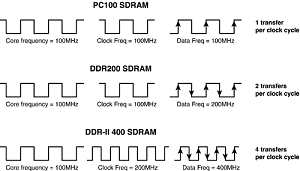DDR SDRAM
Double data rate (DDR) SDRAM memory is a JEDEC-created standard that is an evolutionary upgrade of standard SDRAM in which data is transferred twice as quickly. Instead of doubling the actual clock rate, DDR memory achieves the doubling in performance by transferring twice per transfer cycle: once at the leading (falling) edge and once at the trailing (rising) edge of the cycle.
This is similar to the way RDRAM operates and effectively doubles the transfer rate, even though the same overall clock and timing signals are used. Figure below shows the DDR SDRAM DIMM.

DDR found initial support in the graphics card market and since then has become the mainstream PC memory standard. As such, DDR SDRAM is supported by all the major processor, chipset, and memory manufacturers.
DDR SDRAM first came to market during 2000, but it didn't really catch on until 2001 with the advent of mainstream motherboards and chipsets supporting it. DDR SDRAM uses a new DIMM module design with 184 pins. Figure below shows the DDR SDRAM DIMM.

DDR DIMMs come in a variety of speed or throughput ratings and normally run on 2.5 volts. They are basically an extension of the standard SDRAM DIMMs redesigned to support double clocking, where data is sent on each clock transition (twice per cycle) rather than once per cycle as with standard SDRAM.
To eliminate confusion with DDR, regular SDRAM is often called single data rate (SDR). The bandwidths listed in these tables are per module. Many recent chipsets support dual-channel DDR memory—a technique in which two DDR DIMMs are installed at one time and function as a single bank with double the bandwidth of a single module.
For example, the Intel 865 and 875 family chipsets use dual-channel DDR memory. They support the 800MHz Pentium 4 processor front-side bus (FSB), which transfers 8 bytes (64 bits) at a time for a bandwidth of 6,400 MBps (800x8 = 6400).
With an 800MHz FSB processor installed, these boards use standard PC3200 modules, installed two at a time (dual-channel), for a total bandwidth of 6,400 MBps (3,200 MBps x 2 = 6,400 MBps). This design allows the memory bus throughput to match the CPU bus throughput exactly, resulting in the best possible performance.
You can optimize PC design by ensuring that the CPU bus and memory bus both run at exactly the same speeds (meaning bandwidth, not MHz), so that data can move synchronously between the buses without delays.
DDR2 SDRAM
JEDEC and its members have been working on the DDR2 specification for several years now, and the specification is finally coming to fruition. DDR2 chip and module production began in mid-2003, and the first chipsets and motherboards supporting DDR2 will appear in the first half of 2004.
DDR2 SDRAM is simply a faster version of conventional DDR-SDRAM memory: It achieves higher throughput by using differential pairs of signal wires to allow faster signaling without noise and interference problems.
Originally, it was thought that DDR2 was going to be a quad-data rate solution, but that is not the case. DDR2 is still double data rate, but the modified signaling method enables higher speeds to be achieved. The original DDR specification tops out at 400MHz, whereas DDR2 starts at 400MHz and will go up to 800MHz and beyond.
In addition to providing greater speeds and bandwidth, DDR2 has other advantages. It uses lower voltage than conventional DDR (1.8V versus 2.5V), so power consumption and heat generation are reduced.
Because of the greater number of pins required on DDR2 chips, the chips typically use fine-pitch ball grid array (FBGA) packaging rather than the thin small outline package (TSOP) chip packaging used by most DDR and conventional SDRAM chips.
FPGA chips are connected to the substrate (meaning the memory module in most cases) via tightly spaced solder balls on the base of the chip. Volume production of DDR2 chips and modules has started in the latter part of 2003, with supporting chipsets and motherboards to be released in the first half of 2004.
Variations of DDR2 such as G-DDR2 (Graphics DDR2) are being used in some of the higher-end graphics cards as well. Because all the major memory and chipset manufacturers are supporting DDR2, there is little doubt that DDR2 will become the most popular form of memory after conventional DDR.
DDR2 DIMMs resemble conventional DDR DIMMs but have more pins and slightly different notches to prevent confusion or improper application. For example, the different physical notches prevent you from plugging a DDR2 module in to a conventional DDR (or SDR) socket. DDR2 memory module designs incorporate 240 pins, significantly more than conventional DDR or standard SDRAM DIMMs.